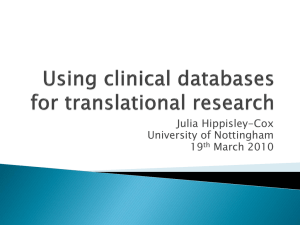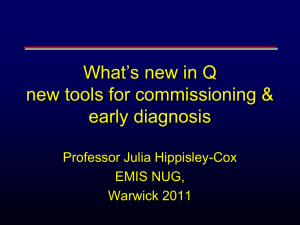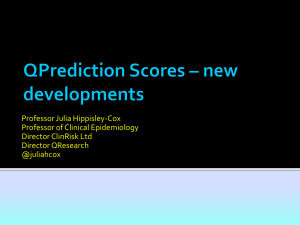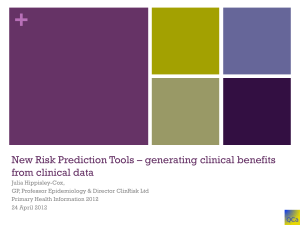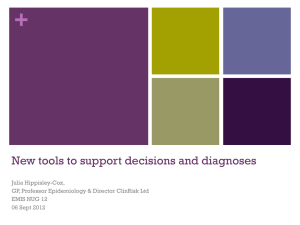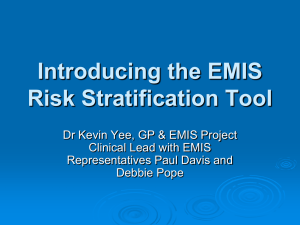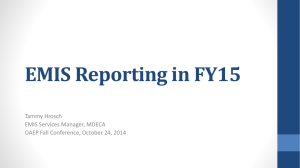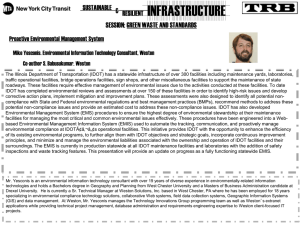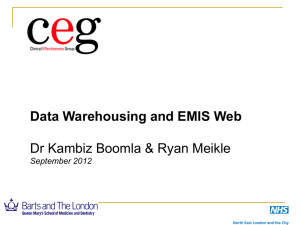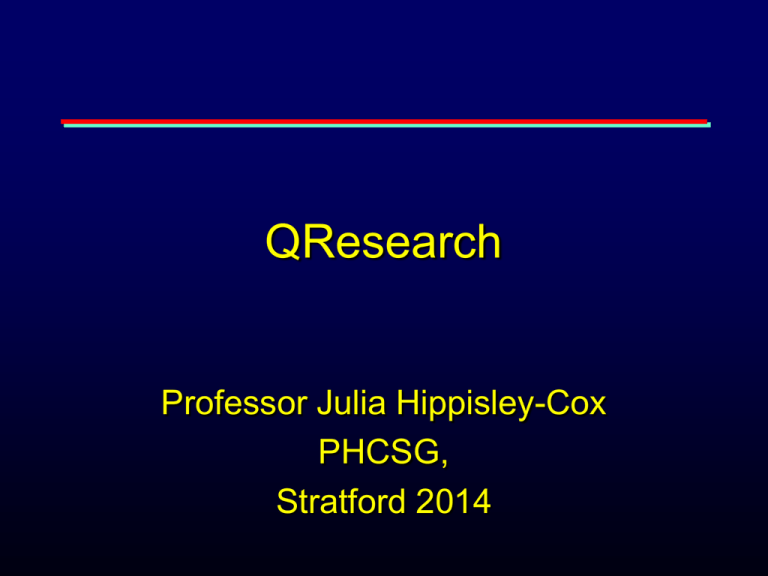
QResearch
Professor Julia Hippisley-Cox
PHCSG,
Stratford 2014
JHC roles
•
•
•
•
•
•
•
Sessional GP in Nottingham
Professor epidemiology & GP Notts Uni
Director QResearch
Member PHSCG committee
Member EMIS NUG committee
Director ClinRisk Ltd
Member Confidentiality Advisory Group
Acknowledgements
•
•
•
•
•
•
•
Contributing practices
EMIS NUG
EMIS
University of Nottingham
QResearch Advisory Board
ClinRisk (software)
Co-authors/researchers
Overview
•
•
•
•
•
QResearch
QData Linkage Project
Risk prediction tools
QSurveillance
QFeedback
QResearch – what is it?
•
•
•
•
•
•
•
•
Patient level pseudonymised database
Not for profit partnership UoN & EMIS
Started in 2002
Ethical research
EMIS systems used in > 55% of UK
First research database from EMIS
Pilot including 40 practice for 1 year
Currently >900 general practices
QResearch – why set up?
• David Stables co-founder of EMIS (1987) &
QResearch (2002)
• Designed emis systems to facilitate research
to improve health care & help GPs make
better diagnoses & Rx decisions
• UoN strong track record using MIQUEST to
extract GP data for academic research
• MIQUEST not working & not scalable
• Both interested in ethical research
QResearch Governance
• Strategic decisions taken by Manageemnt
Board representing EMIS & UoN
• Dr Shaun O’Hanlon (ex-GP Chief Medical officer)
• JHC (current GP & academic)
• Scientific board approves access to data
• Advisory board sets policy & oversees
operation & governance database
• Annual review by REC
• Assessment by ECC/CAG
QResearch Advisory ToR
•
•
•
•
•
Oversee general working
Oversee comms with & benefits to practices
Agree criteria & principles of access
Oversee application of criteria
Review any changes to context, content or
data usage
• Advise on policy for access
• Advise on professional issues
QResearch Advisory Members
•
•
•
•
•
•
•
EMIS NUG
Patient representation
RCGP
BMA/GPC
Society for Academic Primary Care
UoN
EMIS
QResearch - what used for?
•
•
•
•
•
•
Solely used for research projects
Generation new knowledge
Testing or generating hypotheses
Intended for publication in academic journal
Subject to rigorous peer review
All projects must be published
QResearch
CANNOT be used for
•
•
•
•
•
•
Non-research projects
Identifying patients or practices
Clinical trials
Delivering interventions
Political purposes
Projects which wont be published
QResearch practice
engagement
• Practices need to opt in by activating sharing
agreement in EMIS.
• Can be de-activated at any time
• Individual patients can opt out or opt in
• Just re-consented 900 + practices with move
to EMIS Web
• http://emisnug.org.uk/video/enabling-sharingagreements-qsurveillance-and-qresearch
QResearch benefits
• Contributing to bona fide research by sharing
data safely
• Results from all research publically available
to maximise public benefit
• Publications here
• Includes disease epidemiology, drug safety,
health inequalities
• Helps development of tools & utilities in
clinical systems
QResearch–who can access?
•
•
•
•
•
•
•
•
Lead researchers based in UK universities
Track record undertaking research
Team must include a GP
Freedom & intent to publish
Clinical custodian signs declaration
Undertakes not to try to identify patients
Data stored securely on site in university
Signed licence agreement
Peer review projects
• Clear research question or hypothesis likely
to lead to generalisable finding?
• Output suitable for publication?
• Does team have track record of research
• QResearch appropriate database?
• Are methods appropriate?
• Any risks to ethical position including
identification of patients or practices?
QResearch
what GP data included?
•
•
•
•
•
•
•
•
Pseudonymised NHS number; year birth
Only coded data
Clinical events, values, diagnoses
Prescriptions
Consultations, referrals
No strong identifiers
No free text or attachments
No confidential patients or data items or data
from patients who have opted out
QResearch: what data be
accessed?
•
•
•
•
•
•
Samples of database not whole database
Up to 100,000 GP records
Studies needing > 100K done on site
Studies needing linked data done on site
Remote monitored access to prepared data
Access to development datasets to prepare
code which are run on site
• Only use for specified project
• No onward disclosure/re-use
QResearch–how researchers
specify data requested?
• Application form on web
• Qweb query tools to define data requirements
• Includes code libraries for
•
•
•
•
Read codes/snomed
Drug codes
ICD9 & 10
OPCS codes
• Defining study cohorts inclusion/exclusion
QResearch safeguards
• Clinician lead
• Strong IG framework which limits purposes
(research) and users (researchers)
• Strong oversight by advisory board
• No strong identifiers
• Pseudonymisation-at-source
• Minimisation of variables & sample size
• Use of onsite analysis for large
samples/linked data
QResearch Data
Linkage Project
QResearch Data
Linkage Project
• QResearch database already linked to
• deprivation data
• cause of death data
• Very useful for research
• better definition & capture of outcomes
• Health inequality analysis
• Improved performance of QRISK and similar
scores
QResearch data linkage
project
•
•
•
•
•
•
Inpatient data
Outpatient data
Maternity
Critical care
Cancer registration
Mortality registration
New approach
pseudonymisation
• Need approach which doesn’t extract
identifiable data but still allows linkage
•
•
•
•
•
•
Legal, ethical and NIGB approvals
Secure, Scalable
Reliable, Affordable
Generates ID which are Unique to Project
Applied within the heart of the clinical system
Minimise disclosure
Pseudonymisation: method
• Scrambles NHS number BEFORE extraction
from clinical system
• Takes NHS number + project specific encrypted
‘salt code’
• One way hashing algorithm (SHA2-256)
• Cant be reversed engineered
• Applied twice in to separate locations before data
leaves EMIS
• Apply identical software to external dataset
• Allows two pseudonymised datasets to be linked
Openpseudonymiser.org
•
•
•
•
•
•
•
•
Website has .NET and JAVA implementation
Desk top batch processor
Libraries for integration
Test harness
Documentation
Key server
Screencasts
Used by EMIS, TPP, HSCIC, ONS + various
other CCGs/CSU/companies
Individual assessment
Who is most at risk of current or preventable
disease?
Who is likely to benefit from interventions?
What is the balance of risks and benefits for my
patient?
Enable informed consent and shared decisions
Population risk stratification
Identification of rank ordered list of patients for
recall or reassurance
GP systems integration
Allow updates tool over time, audit of impact on
services and outcomes
Major cause morbidity & mortality
Represents real clinical need
Related intervention which can be targeted
Related to national priorities (ideally)
Necessary data in clinical record
All then available as open & closed source
software & for integration into clinical systems
Embargoed until publication
QScores embedded
• EMIS
• INPS
• SystmOne
• Microtest
• Pharmacies -Boots
• Telehealth
• Occupational Health
• Jaguar
• Morrison’s
• National Grid!
ALREADY IN EMIS WEB
QRISk2
QDiabetes
QStroke
QFracture
QAdmissions
IN PLANNING PHASES
QCancer (release Nov 14)
QKidney
QThrombosis
QBleed
QIntervention
EMIS NUG screen casts courtesy of Dr
Geoff Schrecker & EMIS NUG
http://emisnug.org.uk/video/addingcalculation-template-emis-web
http://emisnug.org.uk/video/runningcalculation-eg-qrisk-group-patients-batchadd
http://www.emisnug.org.uk/
QSurveillance
QSurveillance
•
•
•
•
•
•
•
Real time surveillance system
Daily data from 4000 EMIS practices
30 million patients
Infectious diseases
Vaccine uptake
Only aggregated count data by age/sex
Alerts to and helps manage pandemic
QSurveillance real-time
surveillance
•Largest real time surveillance
system worldwide
•Used to monitor seasonal
outbreaks of disease e.g.
influenza, norovirus
•Real time response to public
health incidents
•Compliments NHS Direct,
RCGP, National Pandemic
Service
Influenza virus particles
Flooding, Oxfordshire, 2007 © HPA, Jane Bradley
QSurveillance
•Core part of the Emergency Response.
Reports to
•
•
•
•
•
•
Public health England
Department of Health
CMO’s Office
Cobra
WHO
Academic Modellers
•Used to make national and local policy
decisions
Examples: Ricin and London
Bombings
Examples:Heatwaves
Examples: Buncefield 2005
Examples: Avon Floods 2007
Examples: Pandemic 2009
September 2009
QFeedback
QFeedback: update
• Interactive tool based on QSurveillance
• Allows practices to view own data compared
• PCT, SHA, UK
• Similar practices
• Graphs, Maps, Export data to excel
• Deployed to 4000 EMIS practice since 2011
• Final of E Heath innovation awards
QFeedback dashboard
Example maps
General application

